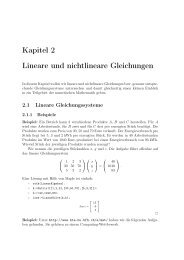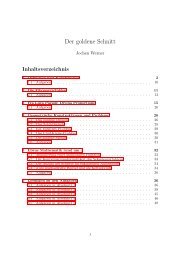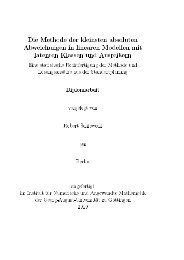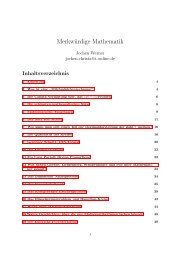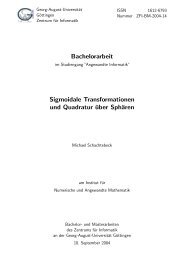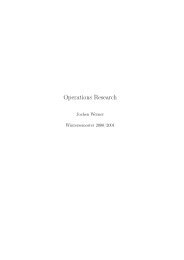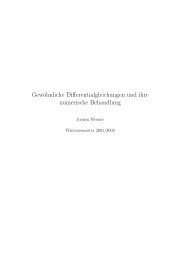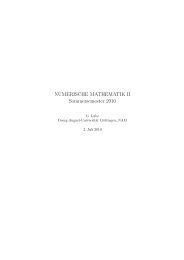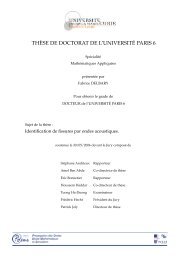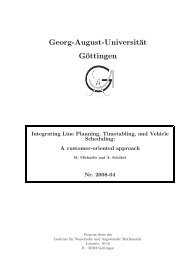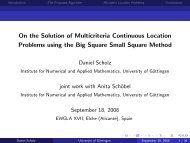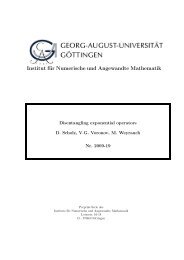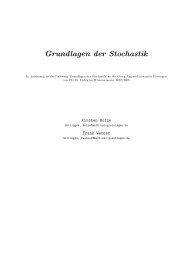BAIL 2006 Book of Abstracts - Institut für Numerische und ...
BAIL 2006 Book of Abstracts - Institut für Numerische und ...
BAIL 2006 Book of Abstracts - Institut für Numerische und ...
Create successful ePaper yourself
Turn your PDF publications into a flip-book with our unique Google optimized e-Paper software.
H. LÜDEKE: Detached Eddy Simulation <strong>of</strong> Supersonic Shear Layer Wake Flows<br />
✬<br />
✫<br />
Detached Eddy Simulation <strong>of</strong> Supersonic Shear Layer Wake Flows<br />
Heinrich Lüdeke<br />
∗ DLR <strong>Institut</strong>e <strong>of</strong> Aerodynamics<br />
and Flow Technology<br />
Lilienthalplatz 7, D-38108 Braunschweig<br />
e-mail: heinrich.luedeke@dlr.de<br />
Tel. +49 (531) 295-3315<br />
Key words: detached-eddy simulation, axisymmetric base flow, compressible wake, turbulent<br />
separation<br />
One challenge <strong>of</strong> numerical investigations <strong>of</strong> unsteady super- and hypersonic flow fields is the<br />
study <strong>of</strong> the turbulent wake at complex vehicle configurations. A recent promising approach is the<br />
technique <strong>of</strong> detached-eddy simulation (DES) proposed by Spalart et.al. Detached-eddy simulation<br />
is a hybrid approach for the modelling <strong>of</strong> turbulent flow fields at complex geometries. The idea<br />
is to combine the best features <strong>of</strong> both, the Reynolds-averaged Navier-Stokes (RANS) and the<br />
large eddy simulation (LES) approach to predict massively separated unsteady flow fields at high<br />
Reynolds-numbers especially in the wake <strong>of</strong> Re-entry vehicles during descent. In this study the<br />
Spalart Allmaras one equation turbulence model is used as an accurate and efficient base for DES.<br />
The intention <strong>of</strong> the current work is an investigation <strong>of</strong> the shear flow in the wake <strong>of</strong> a blunt<br />
cylinder at M =2.4 at high Reynolds numbers. This is used as a basic configuration for re-entry<br />
vehicles with a blunt base. The typical time averaged flow field for this configuration is shown<br />
in fig. 1 with pressure contours and streamlines. The large turning angle behind the base causes<br />
separation and a region <strong>of</strong> reverse flow as visible in the wake. The point at the axis <strong>of</strong> symmetrie<br />
where the streamwise velocity is zero is considered to be the shear layer reattachment point. In<br />
this region the flow is forced to turn along the axis <strong>of</strong> symmetry causing a reattachment shock<br />
to be formed. The detailed experimental data base, provided by Herrin and Dutton [1], is used<br />
for comparison <strong>of</strong> numerically predicted and measured data. The practical applicability <strong>of</strong> the<br />
approach is demonstrated considering as example an axisymmetric re-entry capsule.<br />
All simulations were carried out by the hybrid structured-unstructured DLR Tau code which<br />
is extensively validated for sub- trans- and hypersonic cases [2]. For the axisymmetric cylinderconfiguration<br />
structured and unstructured grids have been generated at different resolution <strong>of</strong> the<br />
turbulent wake. They are designed with a similar resolution used by Forsythe and Sqires in [3].<br />
Especially the near wake <strong>of</strong> the cylinder is refined extensively. The results have shown good grid<br />
convergence for the cylinder cases for all averaged quantities, namely the velocity components and<br />
the pressure, as well as for the diagonal elements <strong>of</strong> the Reynolds stress tensor and the resolved<br />
turbulent kinetic energy in the free shear layer.<br />
In the wake the turbulent kinetic energy and turbulent intensities in radial and streamwise<br />
direction, computed by extracting the standard deviation <strong>of</strong> the velocitys over the time, was successffully<br />
compared with the measurements. Furthermore the pressure level along the base was<br />
compared with the experimental data <strong>of</strong> Herrin and Dutton [1]<br />
Finally simulations <strong>of</strong> the SARA capsule, a facility conceived to be a recovery orbital platform<br />
to perform orbital flights, are carried out to give a practical demonstratin <strong>of</strong> DES modelling for<br />
hypersonic flight [4]. To ensure turbulent wake flow the trajectory point at M =5.1, Re =20· 106 was chosen. The influence <strong>of</strong> unsteady loads, generated by the turbulent wake flow was investigated<br />
for this vehicle. A preliminary snapshot <strong>of</strong> the vorticity contours in the wake is shown in fig. 2.<br />
1<br />
Speaker: LÜDEKE, H. 111 <strong>BAIL</strong> <strong>2006</strong><br />
✩<br />
✪



